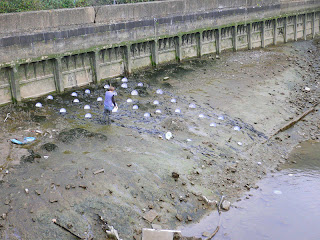There have now been 19 tides (I think) since we installed Creekery. Because of the tides, we installed on 19th September, five or six days before Deptford X opened officially. I knew already from our experiments that there would be a build up of silt on the plates that would dull the blue within four or five days...but when it came to the weekend of the 24th/25th, the first weekend of the festival, and the plates weren't looking so pristine, I worried about going down to clean them. However, the weather and the tides weren't very helpful.
I pondered the necessity of 'cleaning the plates'...it seemed a great many folk expected them to be left as they were and let nature take its course, and weren't in the least bothered that the bright blue had faded. On the other hand, those new to the idea were looking at a postcard of brightly coloured plates and expecting to see it. After all, the festival had only just begun...
I spent a lot of time over the weekend feeling like an OCD housewife worrying about the cleanliness of my plates. It didn't help that when I went to see Liz Harrison's award winning installation of bird song at Deptford Station that my attention was drawn to the filthy state of the station. Everything in Deptford felt filthy.
There was so much going on with open studios and actual paid work (I had to work on Sunday) that I had hardly had time to do the washing up in my own home. Then one of my patrons wrote to say she had been along to see the piece and "it was filthy"...
However, I was also quite keen on the idea of a TERRACOTTA ARMY of plates marching across the Creek, which was what was happening all too quickly. So I was quite undecided today (yesterday) when I went over to the bridge to make a judgement call. Either I would decide to clean them or I could leave them to get so muddy they would be half moons of mud by the end of the festival on Sunday and that could be equally great.
It was the second day this week that the Creekside Centre was hosting a school party. I had expected to see, when I went over to the bridge, Nick Bertram and a class of school children and their teachers in the Creek below. However, what I saw was three people in yellow jackets surveying the walls of the Creek. I suddenly realised they (and I) were looking at bare walls.
The "yellow jackets" were the Environment Agency, and they had just removed ALL the shrubbery from the terraces. They had done this without consulting anyone from Creekside Centre, and Nick, who was just about to take a class of kids down to explore the Creek, was absolutely livid. All the plants – the flora that he talks about and refers to on his walks – had been cut down.
This was it when Charles Shearer photographed it just less than two weeks ago...
As far as Creekery is concerned, they had torn down all the plants in our 'dresser', leaving the crockery exposed. They had moved the vulnerable teacup (that we hadn't weighted down) that sat next to the teapot (that we had weighted down) and which had been bolstered by the plants in the terrace, down to the lower terrace where it would surely get carried away. The big plate on the top shelf was left vulnerable cos it wasn't dug in but had been supported by the now missing greenery, and they had knocked over five plates in the mud near the terrace like they were skittles in a bowling alley...
I looked across and the left bank (or right bank depending on your view) looked OK...but barren of growth...
I had to do something. Fortunately I knew the tide was out for a while, especially since Nick was just taking the kids out...so I got my waders and went down with a sponge (wetted by the outgoing tide), rearranged things, and got the built up silt off every plate, finishing just about the same time as Nick returned from down south with the kids. They assembled by the bridge and Nick showed them how to scoop up minnows and shrimp with their nets, whilst I continued on the left bank to polish the plates (no CRB check so absolutely no contact with the kids)...
As I wiped off the last plate, Nick had just finished frightening them with the crabs that live under a piece of corrugated iron and they all squealed with fear when they saw some real live crabs scuttle out. Then he asked them to applaud with clapping hands the old washer woman who'd been cleaning the rockery....
Hope this picture of the young'uns isn't illegal...
I didn't wipe the backs of the plates....Wonder what it looks like from the DLR...
Meanwhile the same joke got cracked again by a volunteer...This Creek is Minging....
I'm hoping now someone can help with a webcam.
Gonna put some teacups in tomorrow (today) to make up for the two that floated away the Monday before last...






.jpg)
3.jpg)
4.jpg)
5.jpg)
6.jpg)
7.jpg)
8.jpg)
9.jpg)
10.jpg)
11.jpg)

































